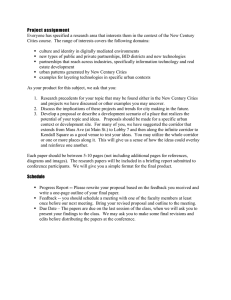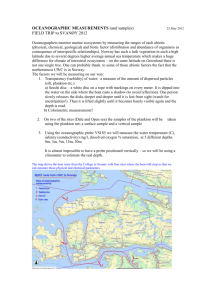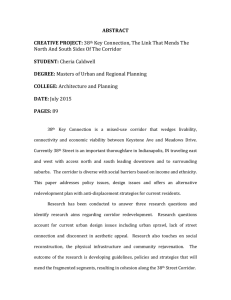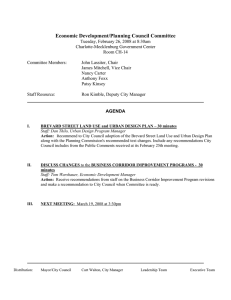• Background • Field program information • Examples of measurements
advertisement
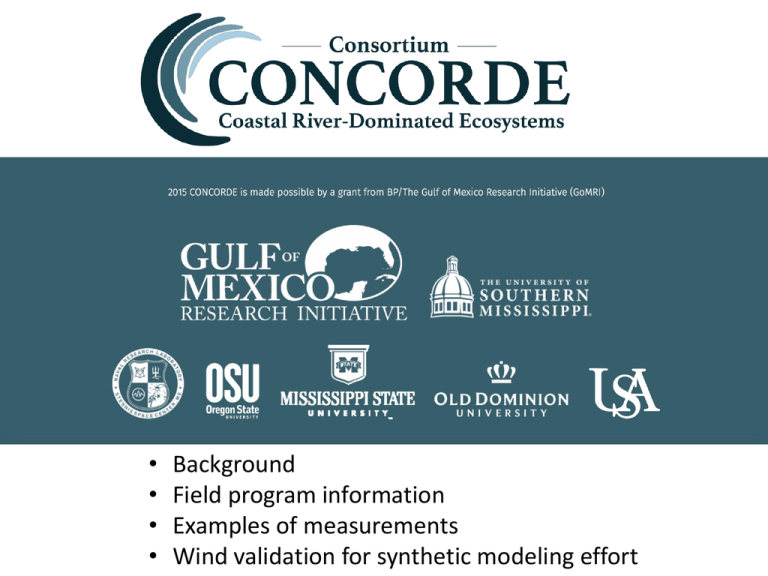
• • • • Background Field program information Examples of measurements Wind validation for synthetic modeling effort How do complex fine-scale structure and processes in coastal waters dominated by pulsed-river plumes control the exposure, impacts, and ecosystem recovery from offshore spills like the Deepwater Horizon release of 2010? Physical distribution and ultimate fate of contaminants associated with the Deepwater Horizon incident (Theme 1) Environmental effects of the contaminants on Gulf of Mexico ecosystems, and the science of ecosystem recovery (Theme 3) Objective 1: Characterize the distribution of planktonic organisms at relevant spatial and temporal scales as forced by the complex near shore physical environment and generating the setting for sub-surface ODS exposure. Objective 2: Characterize the complex 4-D physical, geochemical, and biooptical fields influenced by pulsed river discharge to characterize potential 3-D pathways of ODS to the coast, and mechanisms for enhanced interactions of ODS with plankton, suspended sediment and oil, which determine fate and toxic exposure, and informs synthetic biophysicalecotoxicological models. Objective 3: Generate a synthetic model that incorporates fine-scale 4-D biophysical processes that reveals exposure pathways reflective of DWH, and which will be portable to future spill scenarios impacting similar riverdominated coastal ecosystems. Field program information Plankton Sampling Equipment The plankton sub-project will be collecting zooplankton and ichthyoplankton samples using the MININESS and Neuston nets, image data using the DPI, acoustic backscatter data that further complements our plankton samples and DPI images. In addition, we are also using a FlowCam to identify phytoplankton and microzooplankton species. Mixing was due to remnants of Patricia ISIIS – In Situ Ichthyoplankton Imaging System • • • • Motor actuated wings Temp, salinity, PAR, chl-a, oxygen collected at 2 Hz 16-17 images per second (14 cm * 14 cm * 40 cm) 2 TB of image data every 3.5 hours Temperature measured along 3 corridors with the In Situ Ichthyoplankton Imaging System (ISIIS) (CTD attached to plankton imager) Temperature along the middle corridor for 3 sampling days Example images captured with the ISIIS during the Concorde fall campaign a) siphonophore preying on a larval fish b) larval flatfish c) Two round herring larvae found in dense aggregations d) Doliolid e) Lobate ctenophore (Mnemiopsis spp.) f) larval squid g) trichodesmium h) larval jacks near the bell of a large Aurelia spp. jellyfish Zooplankton captured with the plankton nets to compare to image data Figure 1. Images of plankton from corridor sampling region from Mobile corridor (top) on October 30th to the Eastern corridor (bottom) on October 31st. Photo credits: Hernandez lab. Salinity and Sigma-t from middle corridor on Oct 30 2015 Salinity and Sigma-t from middle corridor on Nov 1 2015 Ocean Weather Laboratory: Daily Now Cast Circulation Models, Satellite Bio-optics, In situ data http://www.usm.edu/marine/research-owx VIIRS Chlorophyll-a, NCOM Current Vectors and Surface Salinity Contours: November 1st, 2015 Fall Cruise Tracks Point Sur Pelican Glider The Ocean Weather Lab provided daily satellite and modeled ocean data to assist with strategic cruise planning, glider deployment, and sampling locations. Ocean Weather Laboratory: Daily Now Cast NCOM High Resolution Current Vectors and Surface Salinity : November 1st, 2015 Satellite Products • Chlorophyll-a • Light Attenuation • Particles • Sea Surface Temperature • Phytoplankton and CDOM Absorption Insitu Field Work • Inherent and apparent optical properties West corridor High Resolution Model Products • Current Vectors and Magnitude • Sea Surface Salinity • Sea Surface Temperature • Mixed Layer Depth • Sea Surface Height • Regional cross sections A B A West corridor Shelf B Objective 3 – synthetic modeling effort RTMA Validation See talk at 4:30PM Room 342 Observations used for validation • • • Used nearest neighbor RTMA with most appropriate land cover Wind observations converted to 10-meter height (when possible) and 1-minute average (when possible) Future data will include WeatherFlow network (new platform installed at Ship Island, funded by CONCORDE) RTMA comparison to observations match well, but there are ouflow boundary issues Upcoming CONCORDE activities • Community workshops with general public, especially commercial fishermen • Teacher workshops • Spring cruise for high river season • Bonnet Carre Spillway opening also being assessed • Results presents at GOMRI conference in early February, Tampa
